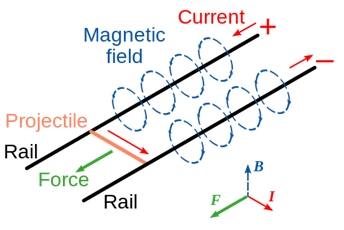A
homopolar motor is a direct current (DC) electric motor which produces constant
circular motion. This device is easy to create and the figure below illustrates
the basic concepts behind its operation. A permanent magnet is attached to one
terminal of a DC power supply, in this case a AAA battery. A conducting wire
connects the other terminal to the magnet, thus completing the circuit. This
wire should be free to rotate whilst always maintaining contact with both the
terminal and magnet. The current (I) flowing through the wire will produce a
magnetic field. This field will interact with the magnetic field (B) produced
by the permanent magnet, and a Lorentz force (F) will be exerted perpendicular
to the directions of I and B. As you look at the diagram, the force on the left
section of the wire is acting into the screen and the force on the right
section is coming out of the screen. As the wire can move freely, these forces
cause the wire to rotate in a clockwise motion. Because the polarities of the
magnetic fields do not change (hence the name homopolar), the direction of the
force will not change and the wire will rotate in a constant circular motion.

As
mentioned above, it is the Lorentz force acting on the wire which causes it to
turn. This force results from the interaction of the electric and magnetic
forces in electromagnetic fields. In the presence of a magnetic field, a moving
charged particle, such as an electron carrying the current in the wire, will
experience a force.The direction of the
force can easily be determined using the right hand rule; the index finger
points in the direction of the current flow, the middle finger points in the
direction of the magnetic field and the thumb reveals the direction of the
force.

The
discovery of the homopolar motor was surrounded by controversy. Michael Faraday
was the first to successfully build the device in 1821. However, this
achievement came after his discussions with the scientists Humphry Davy and
William Hyde Wollaston, who had also been trying to create electric motors. Faraday’s
design featured continuous circular motion that was produced by the magnetic
force around a wire which stretched into a pool of liquid mercury containing a permanent
magnet. Faraday presented his creation to the Royal Society and published his
results without acknowledging the work of the other two scientists. This
scandal damaged Faraday’s reputation at the Royal Society, limiting his
subsequent involvement in electromagnetic research.
Based
on the same general principles as the homopolar motor, rail guns have been of
interest to the military since the early 1900s. A simple rail gun differs from
a standard homopolar motor in that it does not use an external magnetic field. A
pair of conducting rails connected to a power supply is joined by a sliding
armature (or conductive projectile) to complete the circuit. A current flows
down one rail, through the armature and back along the other rail. The current
produces a magnetic field within the loop formed by the power supply, rails and
armature. Similarly to the homopolar motor diagram above, a magnetic field will
be produced perpendicular to the current and the plane of the armature and
rails. As both the current and magnetic field act in opposite directions along
each rail, the Lorentz force produced will accelerate the armature along the
rails. This acceleration can launch a projectile to hypersonic speeds. However
very large currents, and therefore large power supplies, are required and so
much heat is generated that the rails can be eroded. Due to these practical
complications, rail guns are still at the developmental stage. However, the
U.S. Navy have been able to accelerate a 7 pound projectile to velocities of up
to 8,600 km/h using experimental technology.

It is possible to turn a homopolar motor into a homopolar generator. If the
conducting wire is physically turned, this motion will produce a current and a
DC voltage between the battery terminals. This phenomenon was also discovered
by Michael Faraday, who invented the Faraday disc. Whilst this device was
incredibly inefficient and not suitable for use as a practical power source, it
did pave the way for the development of the modern dynamos found in a variety
of gadgets today, such as wind up radios and flashlights.